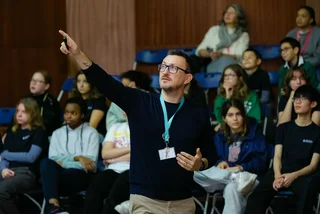Vendula Kobzová’s life as a teacher has always centered around a British-Czech education. Working first in Britain and now back home in the Czech Republic, she places a high value on the values and skills fostered by a British-style education, which are in focus at the Prague British International School.
At PBIS, Vendula is the head of the faculty of experimental sciences and a teacher of physics and mathematics. This puts her at the forefront of the implementation of new scientific advancements in education, as excitement – as well as some concern – grows among the general public about the potential effects of artificial intelligence and other new technologies on education.
For Kobzová, the key is keeping up with the latest changes while ensuring that the intellectual, social, and emotional development of children always comes first. She spoke to Expats.cz about teaching at one of Prague’s leading international schools, PBIS’s impressive educational programs and opportunities, and adapting in an era of rapid technological change.
Tell us about your path to working at PBIS. What do you love about teaching, and why is a British-style education so valuable?
My teaching career started in the 1990s when I went to the UK straight after I finished my Master’s degree. At that time the Czech Republic wasn’t in the EU, so all I could do was to help out as a volunteer, observing and teaching some lessons in UK schools.
I was so inspired that I stayed in the British system ever since. I had fallen in love with the experimental approach that contrasted so much with my own experience as a student. The British curriculum emphasizes critical thinking skills, and this immediately resonated with me, allowing me to apply the creativity I had gained as a summer camp leader and as a naturally hands-on person!
When I started teaching at my first international school in 1999, and especially after moving to Prague in 2001, I was amazed by the level of motivation of students and the welcoming and friendly atmosphere. One aspect I have always loved about my job is getting to meet people from all over the world without traveling. Another thing I adore is that even after teaching physics and math for over twenty years, it never gets old, and I get to have fun from 8 o'clock until 4 o'clock every day.
What’s special about PBIS’s STEAM offer and the wider educational environment for students?
The science department typically gets excellent exam results, as we’re a solid team of experienced teachers working in inspiring learning spaces. We’re very lucky to be supported by first-class lab assistants who make the impossible happen. Mr. Toman, our physics lab tech assistant, is a true magician who can create any piece of equipment we teachers dream up, from a wind tunnel where students can test out their model plane wings, to spectroscopes for the whole class to observe emission spectra.
Our students are extremely motivated, and our “Maker” space buzzes with activity all day long. Last year, several students made their own Stirling engines from meat cans and represented PBIS in a contest at the National Technical Museum. A typical lunchtime and after-school activity is building LEGO robots to compete (and win) at tournaments across the country. Pupils have also built small cars running on hydrogen fuel cells.
This year, our students took on an even greater challenge, signing up for the Horizon Hydrogen Grand Prix. It’s truly amazing to see the dedication of our student team who have assembled a racing car, working tirelessly every day to create it, fix it, and test it for the 4-hour race. They have hydrolyzed distilled water to fill up hydro sticks that power the engine. Everything they learned and read about future energy sources is right there for them to touch and test in real life.
At first, I thought that I should be on top of all our STEAM (Science, Technology, Engineering, Arts, Mathematics) activities, but I quickly realized that this is impossible. While I took a lot of inspiration from an MIT training session that Nord Anglia ran for our STEAM teachers, I put my trust in our STEAM Ambassadors – students elected every year to be in charge of STEAM projects and who learn from each other. This community is something I am very proud of.
We have “gurus” for our laser cutting, 3D printing, student club leaders, student-led software courses, and of course, the hydrogen car project. The ambassadors are at the heart of the STEAM community of like-minded people at our school. Their job is to attract more students to STEAM projects and make sure they pass on the legacy to younger schoolmates.
This means they lead STEAM clubs that are always full and attended by students from our lower school campus. Activities include making smart houses with Micro:bit, a forensic club that’s really great fun, a 3D design and printing club, and an app inventor – all attended by students from younger years, who will naturally grow into STEAM leaders at the senior campus. Of course, this STEAM community is just one of many similar “societies” active at PBIS.
How active are girls in this community? Do you see an increase in girls’ interest in STEAM subjects at school and, later, in higher education?
This is an interesting question. The main difference is that while boys interested in STEAM tend to focus their attention on STEAM projects only, girls’ pursuits are often mixed with other activities. That means boys who regularly come to the Maker space come almost every day, whereas girls spend time in other societies as well. Rather than having a lower interest in STEAM, they simply have a wider range of interests and activities. That’s just my observation.
Many of our female International Baccalaureate students go into science and engineering careers. Less go into IT, although the number taking our Computer Science course offered as an IB subject has increased tremendously in the past 5 years.
Girls also participate strongly in our projects. Thanks to Nord Anglia’s MIT collaboration, we’re able to talk to experts and run an extensive project on a contemporary issue every year. Last year the theme was Extreme Weather, with students constructing warning mechanisms and designing structures to perform in extreme conditions. It was excellent to see girls thriving on this project and taking the lead.
Is it tricky for you to make sure that you keep up with the latest scientific developments as a teacher of science and math?
Absolutely! I often feel my head is about to burst when students come in asking: “Have you seen the newest…”, and I have to work hard to keep up. Teachers are obliged to be lifelong learners, always seeking out opportunities to get to know new technologies.
I often enroll in online courses for educators that help me stay up-to-date. However, we shouldn’t aspire to master all the latest knowledge or to be familiar with all the technology that our students use. Our job is to foster social-emotional learning, creativity, and ethical ways to use technology.
The older I get, the more I understand that I cannot be the carrier of all knowledge in my field. Instead, I seek sources and opportunities for students to develop their STEAM talent and enhance each other’s learning in our STEAM community.
Are developments in artificial intelligence (AI) already impacting approaches to education? What are the potential benefits and drawbacks of AI from an educational perspective?
I think AI affects all areas, not just STEAM subjects. When generative AI such as ChatGPT became “the thing,” I had to rethink my assessment strategies and make students address applications of physics to situations they have encountered, evaluate the models we created in class for gravitational and electric fields, and synthesize the information they had available.
Students need to understand that generative AI is occasionally wrong, so we also need to teach them how it functions and how to make the most of it. It’s fine for them to use it as a supportive tool to develop a concept that they already understand.
Vendula Kobzová, PBIS science teacherWith the rise of AI-provided personalized learning, the era of sitting in a front-facing classroom, listening to the teacher, and copying from the board is over. Instead, we should focus on fostering a thorough understanding of the concepts we want to deliver, modeling them, applying them, and promoting collaboration.
Do you have any suggestions for steps that schools should take to minimize or optimize the impact of AI?
I am by no means an expert, as I am also climbing a steep learning curve on this subject. But I don’t think minimizing AI’s impact on education is the way to go. Moderation, I would believe, is the way forward, along with educating students and ourselves about the way the technology works. I am taking early inspiration from Andrew Herft’s ChatGPT Teacher prompt guide before developing my own ways of incorporating it into classes, which will change the way I teach. We teachers must accept that in some areas, we will no longer simply pass knowledge on to students.
With the rise of AI-provided personalized learning, the era of sitting in a front-facing classroom, listening to the teacher and copying from the board is over. Instead, we should focus on fostering a thorough understanding of the concepts we want to deliver, modeling them, applying them, and promoting collaboration.
Modern schools need to work as communities, where people learn together by solving complex problems and working on interesting projects, all the while fostering social-emotional learning, creativity, and empathy in students. And of course, active skills. As the role of technology grows, human-to-human interaction is increasingly important for wellbeing, both inside and outside school.
This article was written in cooperation with Prague British International School. Read more about our partner content policies here.












 Reading time: 7 minutes
Reading time: 7 minutes 

























